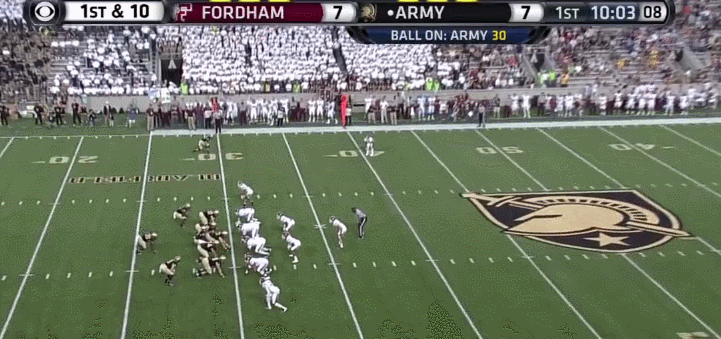Army Football and the Flexbone Offense
As service academies have existed, they have often cultivated their offenses around the option attack most recently shifting from the Wishbone of the 1980s and early 1990s to the double slot Flexbone offense of the late 1990s and 2000s largely pioneered by current head coach Paul Johnson of Georgia Tech while he was coaching at Hawaii and Georgia Southern. Army, under new head coach Jeff Monken has carried on the tradition of this Flexbone offense while adding some wrinkles to it as well.
Monken followed in the footsteps of Paul Johnson as head coach at Georgia Southern, amassing a record of 38-16 from 2010-2013, after previously coaching coaching running backs at Georgia Southern from 1997-2001, the running backs at Navy from 2002-2007, and the running backs and special teams at Georgia Tech in 2008 and 2009 all while closely working with Johnson. His steep knowledge of the system he would inherit as head coach allowed for Monken to immediately be successful at Georgia Southern and upon being anointed head coach at Army in 2014, he led them to a 4-8 record including wins over Ball State and Connecticut and a narrow loss to Wake Forest.
Monken was the man behind the famous game against Alabama, then ranked #3 in the FBS, and Nick Saban in which Georgia Southern amassed over 300 yards rushing and were only down 10 points late in the second half.
As the 2015 season has opened up, new quarterback Ahmad Bradshaw has become a notable name already having thrown for 2 TD and run for 272 yards.

Facing a very stacked box with 9 defenders, Army has the perfect play call dialed up as every single defender surges upfield to try and attack the run but Bradshaw does a great stutter sell first as both A-Backs shoot up field in simple vertical routes. The outside linebacker on the left is caught out of position, letting his A-Back shoot inside of him while the other A-Back catches the safety cheating up expecting a run to the right and is smoothly past him by the time he tries to rectify his mistake. This allows Bradshaw an incredibly easy touchdown throw to the A-Back of his choice and he makes it count.

Army again takes advantage of Fordham presenting the exact same look with the safety cheated way up, almost serving as a middle linebacker, leaving nobody deep to take away the deep throw. Selling the ball to the B-Back helps bring the safety further up, allowing the A-Back to surge past him on another simple vertical route as the outside linebacker on the right opts to take on the motioning A-Back coming towards his side. To his credit, the left outside linebacker recognizes the breakdown immediately and has enough speed to contain the receiver after his catch and Bradshaw holds onto the ball slightly late allowing for a more contested catch and limited yards gained after the catch.

Taking on Connecticut, Monken went back to some simple basics of the Flexbone offense most notably the QB Dive/Draw play where the quarterback keeps the ball from the snap and tries to simply find the open lane. Here, Connecticut does exactly what Fordham did in that they left the deep area of the field exposed despite going three levels deep with a 4-3 Under front (2 linemen shifted towards the weak side of the formation numbers wise) with 3 players lined deep in the middle of the field as safeties.
In a lot of ways, this play is a throwback to the old days of the Single Wing football formation where the quarterback acted as a passer in the pocket and a running back taking a non-existent handoff. Here, Bradshaw displays the “power running” concepts hidden beneath the veer of the option attack and simply follows the B-Back through the gap and utilizes him as a lead blocker. When he gets taken out, Bradshaw does a great job stopping and recognizing the hole in front of him, taking it, and making just enough moves to get to the outside. Take note of the fantastic blocking by the wide receiver, #82 on the play as well. Despite the line of scrimmage being the 44 yard line, the offensive line does a great job just blowing Connecticut’s defensive line right off the ball while allowing the linebackers to get sealed and the safeties coming up to help to get lost in the wash of bodies.
One of the things to keep an eye on in Army and within Monken’s Flexbone option attack is his utilization of different formations including the Shotgun as a way to combat opposing pressure and allow for the ability for his quarterbacks to attack defenses down the field with taller receivers able to out jump shorter defensive backs. While Army may lack the pure talent compared to bigger schools, the option attack and the ability to be varied formation wise allows for Monken and his football team to attack teams up the middle with the B-Back while being aggressive down the seams with the A-Backs as dual running backs/slot receivers.
Those A-Backs can expose teams that try to cheat and go all out in stopping the interior running game. Key on the inside thanks to the B-Back and conceptual plays such as the QB Dive or Double Option (where the quarterback usually reads the backside defensive tackle/nose tackle to give to the B-Back or Keep the ball) and Monken will also attack outside with the more traditional triple option plays utilizing the A-Backs as the pitch men.
Credit to Yahoo for feature image

